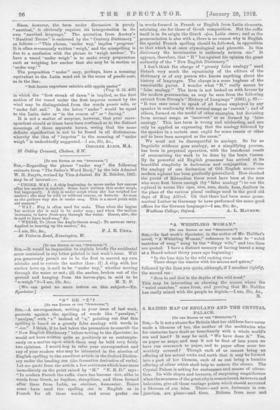A RAISED MAP OF ENGLAND AND THE CRYSTAL PALACE.
[To THE EDITOR OF THE osrservron.n Sin,—Is it not a shame for Britain that her children have never made a likeness of her, the mother of the multitudes who for centuries have dealt so trenchantly with a whole world's sea and land P It may be said, " We have done it." Yee, on paper as maps, and may it not be that of late years we have run overmuch to paper, and to paper often none too worthily covered P Though each of us cannot bring an offering of her actual rocks and earth that it may be formed into a part of her likeness, each of us can bring a humble offering of silver which shall help to redeem the shame. The Crystal Palace is asking for sustenance and means of attrac- tion. Its wide slopes and terraces, of surprising magnificence when the nearness of the great city is remembered, its towers and balconies, give all those vantage points which should surround a likeness of our isles. There—and now, fortunate in con. junction, are place—and time. Britons from near and
from overseas shall pay tribute and, transformed .into.giants a mile high, shall find awaiting them, as it were out of fairy- land, almost veritable seven-leagued boots. Seven-leagued ships also, so that in an hour they may explore all the coasts and channels of their land. Would not Lord Plymouth and his supporters find such an enterprise well worth while from every point of view P It would be a real contribution to the " new geography " and one stimulating in high degree ; stimu- lating, too, in the right way, the way that causes the intelli- gence to reach out in keen quest at its own and not at another's • bidding—the first and last objective in education. To hover over the seas and lands would seem the ideal way, Small
• captive balloons, cars suspended from ropeways; small gyro- scopically balanced monorail carriages running over the roads and railways, all suggest themselves. Your reviewer proposed - paths in the valleys, but at two feet wide they would be dis- figuring, since even on the 25-inch scale they would look like :roads a mile wide. Tides may be made to wax and wane and, for an hour or two daily, to wax until the whole is flooded to the tops of the mountains and a charming view as from mid-air be given to those who float over it in boats. At certain days and times all these externals may be swept aside and the general view alone permitted. Concrete, of white cement and various pigments, makes weatherproof material of any colour. The " expansion joints " it requires would form a network of ten-mile squares over the whole "map," unobtrusive, but just visible enough to give the sense of scale, so vital a matter in all maps. Mr. A. S. Potter, F.R.G.S., suggests a vertical scale three times the horizontal and deprecates much exaggeration. But exaggera- tion is essential: the foreshortening effect on heights is tremendous when the eye can never be much less and is often much more than a mile in scale distance above the ground. ' It results that the exaggerated vertical scale gives for the most part an actually truer impression than that given by one ap- proaching the natural scale. For our little hills and slopes an . X 3 vertical scale is none too much probably ; an Alpine map is a very different affair. The cost need not be prohibitive, especially if effects, broadly true rather than of meticulous accuracy, are sought. Your reviewer wishes that raised maps could be further developed in this country. Ought not this to be put forward strongly P The stimulus and interest which such maps give need no descanting upon. The cost is the difficulty, but while the complete map must cost pounds, the relief part itself—just the bills and dales—without the names
• and ordinary map details shown upon the surface, can, once the mould is made, be oast in it for almost a few pence, certainly for a few shillings. The schools can finish them.—
I am, Sir, &c., W. BREMNER DAVIS, A.M.I,O.E.











































 Previous page
Previous page